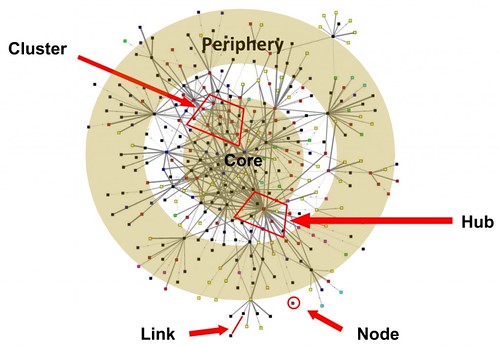Relationships are the heart of many successful social media outreach efforts. They help fuel viral success (second only to exceptional content) and serve as a catalyst for self-organizing online swarms. You need to be able to visualize connections and influence, however, before you can strategically leverage relationships to reach and inspire target audiences. That’s where network mapping comes in.
Depending on your objectives, you can map social media conversations or you can map networks of individuals and organizations to identify hubs, clusters, and links you can leverage to bridge networks or strategically connect people for mutual benefit. You can visualize your connections low-tech or with free or paid digital network mapping tools:
- Low-tech: Networked nonprofit guru Beth Kanter has written multiple blog posts about network mapping (both low and high tech), including ones on the use of sticky notes to map networks at an innovation lab conference and a National Wildlife Federation event. Management Sciences for Health has also developed a five-step, low-tech, low-cost, intuitive, and inter-culturally applicable methodology for mapping networks (see slides 30-32). Although intended for knowledge management baseline and post-intervention evaluation network mapping, the methodology could easily be applied to social media campaign planning and evaluation.
- Free digital tools: NodeXL is a free, open-source template for Microsoft® Excel® 2007, 2010 and 2013 that can easily be paired with the low-tech methods above and others to graph networks and determine the best way to leverage them. For Twitter network analysis, Mentionmap is a free tool that not only allows you to see the people that you have the most conversations with but also the way that other influencial Twitter users connect to you and others. This is particularly valuable for identifying people with small networks with strong ties (i.e., more easily leveraged) or who bridge hubs. Also for Twitter, Hashtagify.me allows you to find the best hashtags and influencers to reach your audience. For Facebook, a free app called Netviz can analyze how your friends connect and you can pull the data into a free open source network analysis software called Gephi. Journalist Andy Carvin produced an interesting Slideshare presentation showing how he used Netviz and Gephi to explore his network connections (hats off to Beth Kanter’s blog where I found this gem). For the tech savvy, Gephi can also be used for a multitude of other social network analysis uses and beyond.
- Paid digital tools: There are many paid social media analytics tools out there, but three stand out for their network mapping abilities. Crimson Hexagon combines network visualization with real-time sentiment analysis to provide accurate and actionable insights about target audiences and their conversations. UberVU provides a real-time view of social activity via a number of informative graphs. These include geographic analysis, spikes and bursts, trending stories, and influencer analysis. Sysomos provides real-time visualizations and in-depth metrics, including geo-demographics and sentiment and influencer analysis.
What is your organization’s strategy for network mapping? What are your takeaways?

Thanks so much for giving Sysomos a shout in here! We really appreciate the recommendation.
Cheers,
Sheldon, community manager for Sysomos